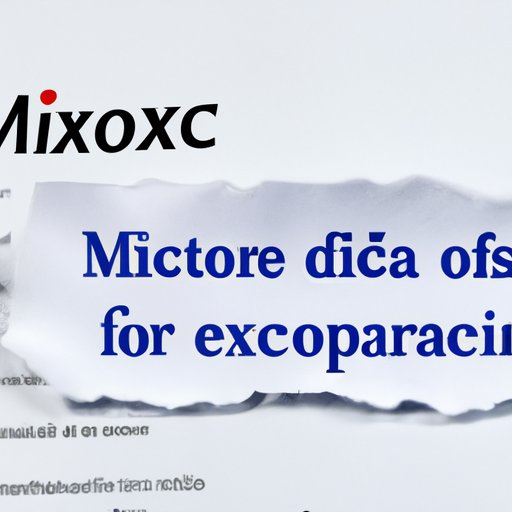
Introduction
Microsoft Word is an indispensable tool for writing, creating, and formatting documents. However, it’s not uncommon to encounter a common problem while using Word: extra pages. These extra pages can be frustrating, especially if you’re working on a tight deadline. Fortunately, knowing how to delete these pages is essential, and this guide will show you how.
This article will explore the causes of extra pages, step-by-step guides on how to delete them, helpful tips and tricks, and layout optimization. By the end of this guide, you’ll have a comprehensive understanding of how to delete extra pages from Word documents.
Step-by-Step Guide: How to Delete an Extra Page in Word
The most common reason for an extra page in Word is the accidental insertion of an unwanted page break. However, you can quickly delete this page by following these simple steps:
1. Place the cursor at the end of the text on the previous page.
2. Click on the “Home” tab.
3. Click on the paragraph symbol in the “Paragraph” section.
4. Select “Show/Hide.”
5. Select the extra page break.
6. Press the “Delete” key on your keyboard.
Alternatively, you can also try the following method:
1. Place the cursor at the beginning of the extra page.
2. Click the “Backspace” key until the unwanted page is deleted.
Tips for Ensuring Successful Deletion
Deleting an extra page using the methods above is easy, but sometimes the page may be stubborn and not delete as expected. Here are some tips to help ensure successful deletion of the extra page:
– Ensure that there are no hidden formatting codes that may be causing the extra page.
– Ensure that the margins are correct and consistent.
– Check to confirm that there is no running header or footer that may be taking up space on the unwanted page.
Common Causes of Extra Pages in Word and How to Fix Them
Extra pages in Word documents may appear for different reasons, including:
– Misaligned or inconsistent margins
– Accidental insertion of page breaks
– Running header or footer that extended to an extra page
– Large font sizes
– Paragraph spacing discrepancies
Here are some tips to prevent extra pages from occurring:
– Always check for formatting anomalies like hidden codes and misplaced page breaks
– Consistently monitor your margins to ensure they align across all pages
– Adjust font sizes and paragraph spacing to meet the required format
– Avoid an automatic page numbering system for headers and footers.
Troubleshooting Advice for Deleting Stubborn Extra Pages
If your extra page is not caused by the above common issues, then you might have to try a few troubleshooting steps:
– Highlight the content on the extra page, then change the font size to the smallest size possible.
– Try re-inserting and removing page breaks.
– Check that all page breaks are the same type and consult with a colleague or friend who understands the functionality of the software.
Tips and Tricks for Editing and Streamlining Your Word Documents
Editing and streamlining your Word documents can save you a significant amount of time while improving the document’s quality and readability. Here are some essential tips and tricks to follow:
– Use the “Navigation Pane” to quickly locate specific parts of your document.
– Delete all the unused styles in your documents.
– Remove any empty spaces and bookmarks.
– Check and fix the grammar and spelling errors.
Shortcuts and Hotkeys for Quickly Deleting Extra Pages in Word
Keyboard shortcuts can be incredibly convenient in accelerating the document editing process. Here are some useful keyboard shortcuts to help you delete extra pages:
– To remove one page using the keyboard, click on the page you want to delete and press “Ctrl”+”G” followed by “Enter”.
– To remove several contiguous pages, click on the first page you want to delete and press “Ctrl”+”Shift”+”End”+”Enter”.
– To remove non-contiguous pages, click on the first page you want to delete, press “Ctrl”+”G,” type in the page numbers, separated by commas, click the “Delete” button, then “Enter”.
Always keep in mind that these keyboard shortcuts may differ based on the version of Microsoft Word you are using.
Tips for Using Shortcuts Effectively to Speed Up Document Editing
Using the correct shortcut keys for the specific task you are performing can save you time and energy which is why it’s crucial to learn some time-saving tips, including:
– Always keep a shortcut list nearby for easy reference.
– Try creating customized shortcuts for specific actions that you perform frequently.
– Learn the basics first before using advanced shortcuts.
Optimizing Your Word Document Layout: How to Delete Unwanted Pages and Enhance Readability
Optimizing your Word document layout involves formatting and styling your composition while also deleting unnecessary pages. Some key considerations when optimizing document layout include:
– Use a consistent formatting style throughout your document.
– Avoid the use of too much text formatting.
– Ensure a consistent margin and spacing.
– Bold and italicize critical information when necessary.
– Keep ornaments and stylizations to a minimum.
Techniques for Removing Unwanted Pages and Optimizing Document Layout
To optimize your document layout and remove unwanted pages, follow these simple tips:
– Use bullet points and lists to break up long paragraphs of text.
– Insert section breaks instead of page breaks to separate the document’s distinct parts.
– Use soft page breaks instead of hard page breaks.
– Manually adjust each section if your document layout has gotten messy.
Conclusion
Extra pages in Word documents are a common occurrence that can be frustrating and time-consuming to address. However, this guide offers a comprehensive approach to resolving this problem. Whether you want to delete extra pages using specific methods, optimize the layout of your documents, or use shortcuts to make your editing process more efficient, you can achieve your desired result. Apply the tips and tricks outlined in this guide and enhance your Word document processing experience.




